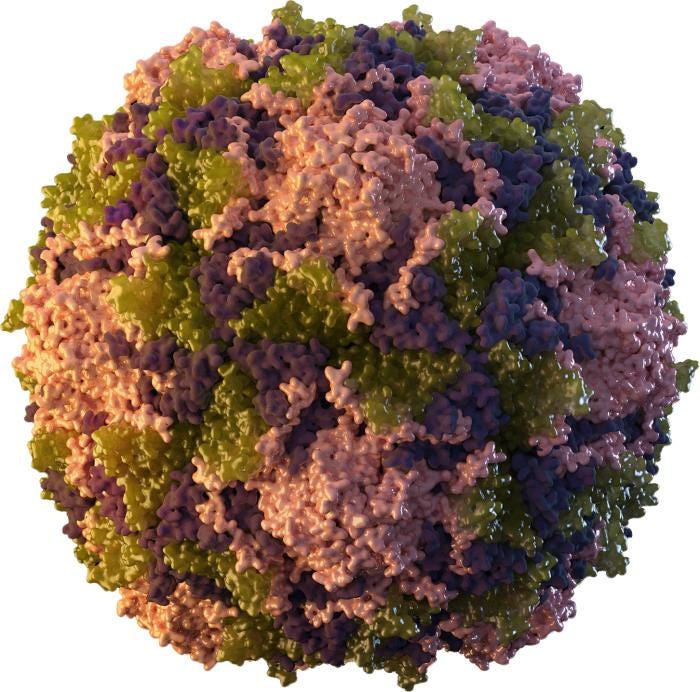The Evolution of the Polio Vaccine: A Triumph Over Paralysis
Written on
Chapter 1: Understanding Polio and Its Impact
Poliomyelitis, commonly referred to as polio, is a debilitating condition caused by the poliovirus, a type of Enterovirus. Prior to the introduction of the polio vaccine in the 1950s, around 35,000 individuals were left permanently disabled each year, and approximately 3,000 people succumbed to the illness annually during the height of the polio epidemic. With the groundbreaking efforts of renowned scientists like Jonas Salk and Albert Sabin, the United States was declared polio-free by 1979. Nevertheless, parts of the Middle East and Africa continue to grapple with the virus, necessitating ongoing vaccination initiatives.
Effects of Poliovirus Infection
Interestingly, nearly 75% of those infected with the poliovirus do not show any symptoms. For the minority who do, there exists a rare possibility (less than 1% of cases) that the virus may invade the spinal cord, leading to paralysis. This can result in respiratory failure and death in 5-10% of affected individuals. Survivors may experience post-polio syndrome, a condition that left President Franklin D. Roosevelt wheelchair-bound. At the time of his diagnosis, it was known as infantile paralysis, despite him being 39 years old.
The Initial U.S. Polio Epidemic and Research Developments
Evidence of a similar paralytic disease can be traced back to ancient civilizations, but the first significant outbreak in the United States was documented in Vermont in 1894, resulting in 18 fatalities and 132 cases of permanent paralysis. It wasn't until after major epidemics in Sweden that researchers identified the disease as infectious. By 1905, the cause of paralysis was established, and it took an additional three years for scientists in Vienna to confirm it was viral. Early public health campaigns emphasized hygiene and cleanliness, as the virus is primarily spread through feces-contaminated food and water, or potentially by flies that contact infected waste.

The Path to the First Polio Vaccine
Dr. Simon Flexner's research at the Rockefeller Institute for Medical Research marked a pivotal moment in the quest for a polio vaccine. In 1910, he discovered neutralizing antibodies against the virus in the blood of monkeys that had survived the disease. The first polio vaccines underwent testing in 1935, but these trials led to tragic outcomes, including deaths and paralysis among participants. A breakthrough came in 1948 when Dr. Hilary Koprowski at Lederle Laboratories achieved better results during his self-experiments, leading to human trials in 1950 with an attenuated oral vaccine. Despite the development of antibodies, his methods raised ethical concerns.
The complexity of vaccine development increased in 1949 when three distinct poliovirus types were identified. That same year, Dr. John Enders successfully cultured the virus in non-nervous system tissues, a feat that earned him the Nobel Prize in Physiology or Medicine in 1954.
Breakthroughs and Challenges in Vaccine Development
Dr. Jonas Salk made significant strides in developing the polio vaccine with support from the National Foundation for Infantile Paralysis, now known as the March of Dimes. On March 26, 1953, Salk announced a successful vaccine on national radio, paving the way for field trials that commenced in April 1954. Over 1.3 million children participated in the randomized trials of Salk's “killed” virus vaccine, which was licensed a year later, offering a 60-70% efficacy rate against poliomyelitis. Unfortunately, some production batches contained inadequately killed virus, resulting in a few cases of disease and paralysis, which led to a temporary halt of the vaccination program.
This video titled "Polio vaccinations | Infectious diseases | NCLEX-RN | Khan Academy" provides a detailed overview of polio vaccinations and their significance in combating infectious diseases.
Sabin's Live-Attenuated Oral Vaccine
While Salk gained recognition for the first licensed vaccine, Dr. Albert Sabin was simultaneously developing an oral vaccine in collaboration with the Russian government. His live-attenuated vaccine, which could be administered via sugar cubes, offered longer-lasting immunity against the virus. By 1959, Sabin had conducted clinical trials involving 10 million children, culminating in the licensing of the first oral polio vaccine in 1960, which targeted type 1 poliovirus. Vaccines for the other types soon followed, and by 1963, a combined oral vaccine was available for all three poliovirus types.
The inactivated vaccine developed by Salk was phased out by 1968 in favor of Sabin's oral vaccine. However, concerns arose that the weakened virus could revert to a pathogenic form, prompting ongoing research in the field.
The Modern Era of Polio Vaccination
In 1997, an enhanced version of Salk's inactivated vaccine was reintroduced, and by 2000, the United States had completely transitioned to using the inactivated form, moving away from live virus vaccines. As of 2020, the only wild poliovirus strain circulating globally was type 1, primarily in the Middle East. The World Health Organization estimates that without the polio vaccine, 18 million people would have faced paralysis, and an additional 1.5 million childhood deaths would have occurred.
However, recent years have seen outbreaks of vaccine-derived poliovirus (VDPV) in areas with low immunization rates, where the oral attenuated virus has mutated. The older vaccine formulation remains in use in lower-income countries due to various challenges, including local skepticism, political barriers, cost, and ease of administration. Efforts are underway to shift regions, particularly in Africa, to the improved inactivated vaccine that has been widely accessible in other parts of the world for years.
For more information on polio vaccination schedules in the United States, visit the CDC's website. To learn about global initiatives aimed at eradicating polio, check out the Global Polio Eradication Initiative.
This video titled "The Early Plan to Fight COVID with the Polio Vaccine" explores historical approaches to utilizing the polio vaccine in combating emerging health crises.